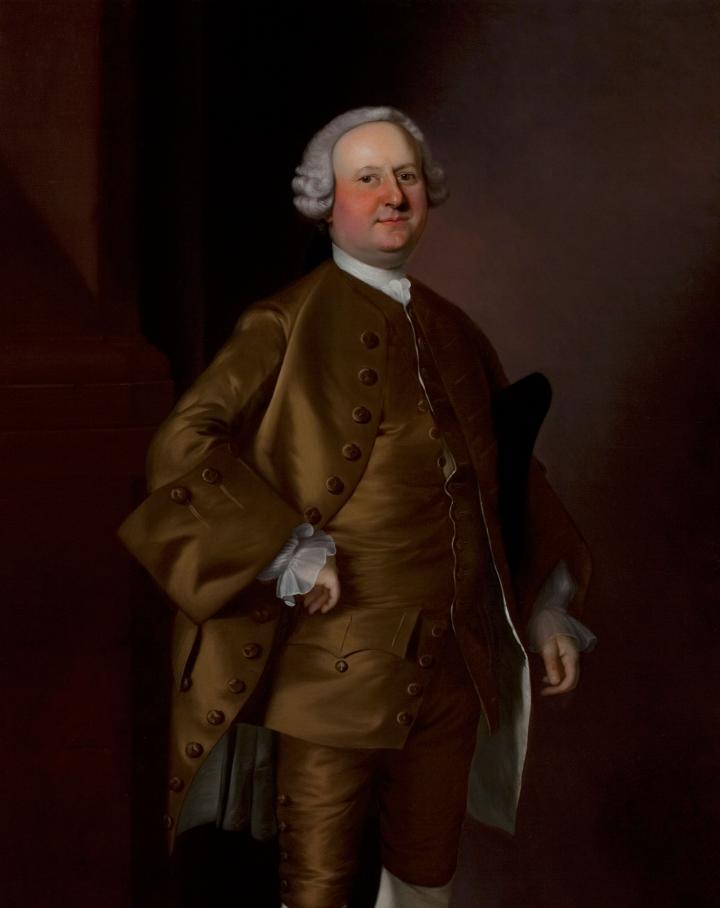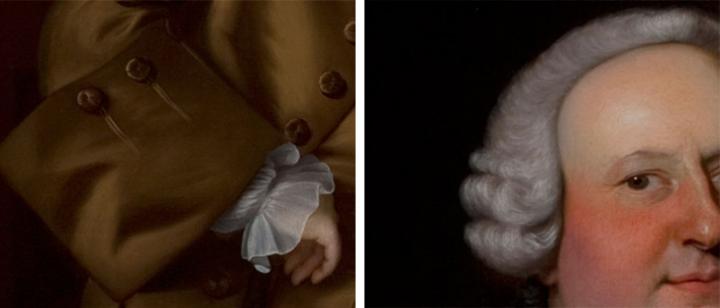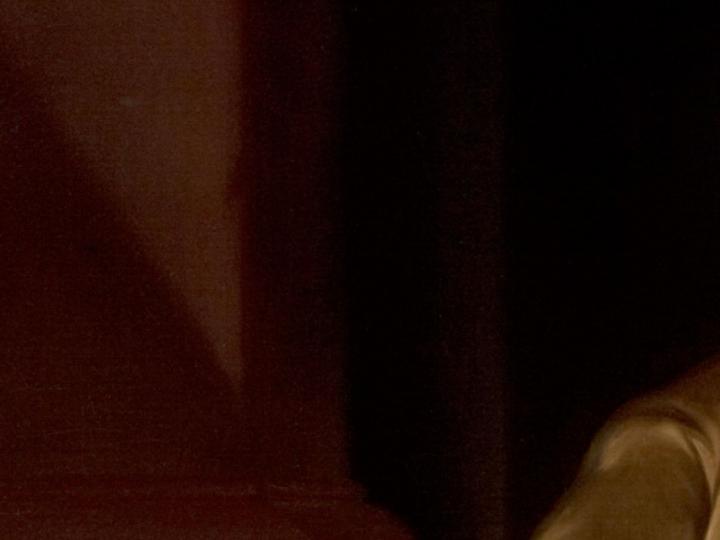
Joseph Blackburn, Jonathan Simpson, 1758, oil on canvas. Purchased through gifts from the Lathrop Fellows, a gift from W. David Dance, Class of 1940, in memory of Jane Dance, and through the Mrs. Harvey P. Hood W '18 Fund, the Florence and Lansing Porter Moore 1937 Fund, the Katharine T. and Merrill G. Beede 1929 Fund, the Class of 1935 Memorial Fund, the Julia L. Whittier Fund, and the Phyllis and Bertram Geller 1937 Memorial Fund; 2007.83.
Based on the Learning to Look method created by the Hood Museum of Art. This discussion-based approach will introduce you and your students to the five steps involved in exploring a work of art: careful observation, analysis, research, interpretation, and critique.
HOW TO USE THIS RESOURCE
1. Print out this document for yourself.
2. Read through it carefully as you look at the image of the work of art.
3. When you are ready to engage your class, project the image of the work of art on a screen in your classroom.
4. Use the questions provided below to lead the discussion.
Step 1. Close Observation
Ask students to look carefully and describe everything they see. Start with broad, open-ended questions like:
* What do you see or notice when you look at this portrait?
* What else do you see?
Become more and more specific as you guide your students’ eyes around the work with questions like these:
* What do you notice about the sitter’s face?
- His pose?
- His clothing?
* What object is he holding under his arm?
* What do you notice about the artist’s style?

Look carefully at some of the details to see how deliberately the artist painted the eyes and skin, as well as the texture of the wig and the fabrics.

* What did the artist include in the background?

Look again at the entire painting within its frame.
* What do you notice about the colors? The frame?
Step 2. Preliminary Analysis
Once you have listed everything you can see about the object, begin asking simple analytic questions that will deepen your students' understanding of the work.
For instance:
* What can you say about this man from the way the artist painted him?
* Why do you think his waistcoat is open in the middle?
(It was customary for gentlemen of this period to rest their hand inside their waistcoat.)
* Why do you think the artist only painted three-quarters of the figure and not his whole body?
(This may have been a financial consideration. A three-quarter-length portrait cost less than a full length portrait. It may also have been an aesthetic choice)
* What is the overall feeling of the portrait? Formal? Informal? A little of both? What would it be like to meet this person?
After each response, always ask, "How do you know?" or "How can you tell?" so that students will look to the work for visual evidence to support their theories.
Step 3. Research
At the end of this document, you will find some background information on this object. Read it or paraphrase it for your students.
Step 4. Interpretation
Interpretation involves bringing your close observation, preliminary analyses, and any additional information you have gathered about an art object together to try to understand what a work of art means. There are often no absolute right or wrong answers when interpreting a work of art. There are simply more thoughtful and better informed ones. Challenging your students to defend their interpretations based upon their visual analysis and their research is most important.
Some basic interpretation questions for this object might be:
* A portrait is meant to commemorate a person for posterity. What did this man want the world to know about him?
* Jonathan Simpson was a successful merchant. How is his portrait the same as or different from the portrait of a king or an aristocrat? (If you like, you can compare this painting to Pompeo Batoni's portrait of Robert Clements, later the First Early of Leitrim, from 1753–5. It is reproduced at the end of this resource.)
* What does this portrait tell us about the values of colonial Americans?
Step 5. Critical Assessment and Response
Critical assessment and response involves a judgment about the success of a work of art. This step optional but should always follow the first four steps of the Learning to Look method. Art critics often engage in this further analysis and support their opinions based on careful study of and research about the work of art.
Critical assessment involves questions of value. For instance:
* Do you think this portrait is successful and well done? Why or why not?
This fifth stage can also encompass one’s response to a work of art. One’s response can be much more personal and subjective than one’s assessment.
* Do you like this work of art? Does it move you?
* How does it compare to images we make of people today?
Background Information
Joseph Blackburn, British, active 1752–1778; active in North America 1754–1762
Jonathan Simpson, 1758
Oil on canvas
Purchased through gifts from the Lathrop Fellows, a gift from W. David Dance, Class of 1940, in memory of Jane Dance, and through the Mrs. Harvey P. Hood W'18 Fund, the Florence and Lansing Porter Moore 1937 Fund, the Katharine T. and Merrill G. Beede 1929 Fund, the Class of 1935 Memorial Fund, the Julia L. Whittier Fund, and the Phyllis and Bertram Geller 1937 Memorial Fund; 2007.83
British painter Joseph Blackburn provided a pivotally important example of the British rococo to Colonial America, where he worked from 1754 to 1762. Little is known of Blackburn's origins, but his poses and his skill in painting lace and other clothing details point to a familiarity with high-style British portraiture. He was among the handful of portrait painters active in New England before the ascent of native-born John Singleton Copley (1738–1815), who matured as an artist in the late 1750s under Blackburn's influence. Copley's emergence as a serious competitor likely persuaded Blackburn to move to Portsmouth, New Hampshire, by 1760, and to England in 1763.
Jonathan Simpson (1711/12–1795) succeeded his father as a Boston storekeeper— primarily of hardware—and in 1754 married Margaret Lechmere (1719–1778). (Their pendant portraits, also by Blackburn, are in the Museum of Fine Arts, Boston.) Simpson may have commissioned this portrait to mark his enhanced social status after his marriage four years previously into one of Boston's most prominent families. He would have known Blackburn's work because his father, the elder Jonathan Simpson (1684–1763), had sat for Blackburn the previous year (D'Amour Museum of Fine Arts, Springfield, Massachusetts). In addition to his propitious marriage, the younger Simpson took other steps that advanced his standing within a wealthy circle of Boston merchants with close ties to Great Britain. Significantly, he did not join the Congregational Old South Church, of which his father was deacon, but as early as 1740 allied himself with Boston's Episcopal Trinity Church, an extension of the Church of England. As the years progressed, Simpson was described no longer as shopkeeper but as "importer," suggesting his wider ambitions and financial successes. As tensions with the Mother Country mounted, he became a prominent loyalist and fled Boston with his wife in 1775. After spending a year in Halifax, Nova Scotia, he settled in Bristol, England, where he remained until his death.
In contrast to some of Blackburn's earlier work in the Colonies, this portrait retains only vestiges of the decorative rococo style. Blackburn presents Simpson in a more natural stance and within a composition that includes little adornment beyond the sumptuous fabric of Simpson's beautifully tailored satin suit—the most obvious marker of his wealth. He also wears a powdered wig and holds a tri-cornered hat, both fashionable accessories sported by the upper classes. The waistcoat's open button at the chest reflects another fashion convention, one that enabled a gentleman to rest one hand over his breast in a gesture of leisure. With his direct gaze and slight smile, Simpson conveys a stately yet pleasant aura of confidence and ease. The matter-of-fact realism of his likeness contrasts with the more decorative, flattering, and compositionally complex British portraits of the aristocracy—at least those painted in urban centers by highly trained artists.
Portraits are often commissioned with the intention that they will be passed down within a family as memorials to the deceased sitters. As the Simpsons had no children, Jonathan Simpson gave this portrait to a favorite niece (probably before he left Boston), and it descended in the Osgood family of Salem and Boston, Massachusetts, until 2007. The pair of Blackburn portraits that depict both Simpson and his wife, on the other hand, descended through her family. The earliest American painting in the Hood's collections, this work retains its original frame, which was probably imported from London.